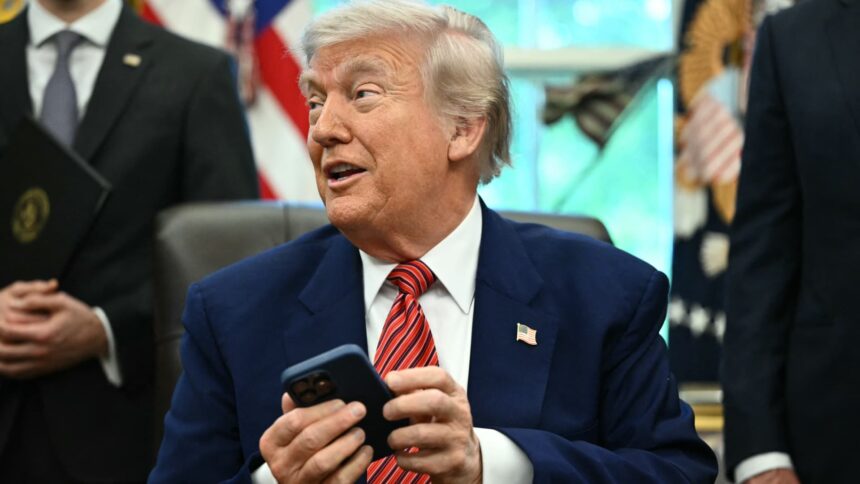The president of the United States, Donald Trump, prepares to sign executive orders in the Oval Office of the White House in Washington DC.
The president of the United States, Donald Trump, is expected to find a solution after suffering a great blow to a central part of his economic agenda.
The United States International Trade Court ruled on Wednesday that the President had exceeded his authority by invoking the International Law of Emergency Economic Powers (IEEPA) to impose on tariff countries.
The Manhattan Court not only ordered a permanent high to most Trump’s rates, but also forbidden future modifications.
A panel of three judges gave the White House 10 days to complete the formal process of stopping the rates. The Trump administration quickly appealed the ruling.
The economists ate Goldman Sachs He said that the White House has some tools at your disposal that could ensure that it is just a temporary problem.
“This ruling repeats a setback for administration’s tariff plans and increases uncertainty, but it might not change the final result for most of the main US commercial partners,” said Goldman Sachs analysts in a research note.
“For now, we hope the Trump administration will find other ways to impose tariffs,” they added.
Table options
The Wall Street bank said the ruling blocks the 10% reference rate driven by Trump in most imports, as well as additional rates, Canada and Mexico, but not sectoral rates, such as those imported in steel, aluminum and cars.
The Trump administration has other legal means to impose tariffs, however, according to Goldman. These include section 122 of the 1974 Commerce Law, section 301 and section 338 of the 1930 Commerce Law.
Section 122 does not require formal investigation and, therefore, could be one of the fastest ways to move through the judicial obstacle.
“The administration could quickly replace the 10% rate on the board with a similar rate or up to 15% under Sec. 122,” said Goldman analysts. However, they noticed that such a measure would only last up to 150 days, after which the law requests the action of Congress.
Trump could also quickly launch research from section 301 on US commercial partners, establishing bureaucratic bases for rates, although Goldman said the process will probably take several weeks at least.
Section 232 of the tariffs, which are already in place for imports of steel, aluminum and cars, could also arrange other sectors, while section 338 allows the president to impose taxes of up to 50% in imports of countries that vanished to the United States.
Goldman said the latter has not used the leg before.
What about the Supreme Court?
James Ransdell, partner of the Cassidy Levy Kent law firm, said that the opinion of the court marks the first of many other cases that are still pending, and the first substantive opinion of the Federal Court “to really address the meat of the challenge of the plaintiffs.”
Ransdell said that the speed of the Appeal of the Trump administration was “very unusual” and suggests that the government could be working during the night to prepare its motion an emergency stay of the order.
He added that it was “certainly a possibility” that the Supreme Court could end up having the last word.
“There is not much or precedent in this particular statute and in similar actions of the president, so there could be interest that the Supreme Court has been doing,” Ransdell told “The China Connection”
Steven Blitz, US chief economist in Ts Lombard, said Trump had a “very good” level of understanding how to play courts to obtain what Hey in terms of playing over time.
“The first thing that will probably make an emergency appeal before the Supreme Court … wanting to obtain a decision from them that basically says that you can keep these rates in place while the appeal process extends,” said Blitz in the day.
“This real executive order always was going to, at some point, ran into the courts … the difference between being a monarchy and being a constitutional democracy is the legal system,” he added.
Shares, the increasing US dollar
Variable rental markets around the world increased widely Thorsday’s day when investors reacted to legal ruling. Asia-Pacific markets ended the most majority day and US futures. UU. They jumped.
However, the market reaction in Europe was more silenced, with the Stoxx 600 paneuropeo a single 0.2% in mid -morning.
Jordan Rochester, Chief of Strategy of FICC in Mizuho Emea, said in a note that the limited reaction of the market was “because Trump still has several options to increase tariffs.”
“Things are more complicated, but the ultimate goal for Trump remains the same. In politics, when there is a will, there is a way,” he said.
The US dollar rose slightly against the main rivals, with the US dollar index 0.14%higher. So far this year, the dollar index has fallen about 8% amid the continuous agitation of the market.










